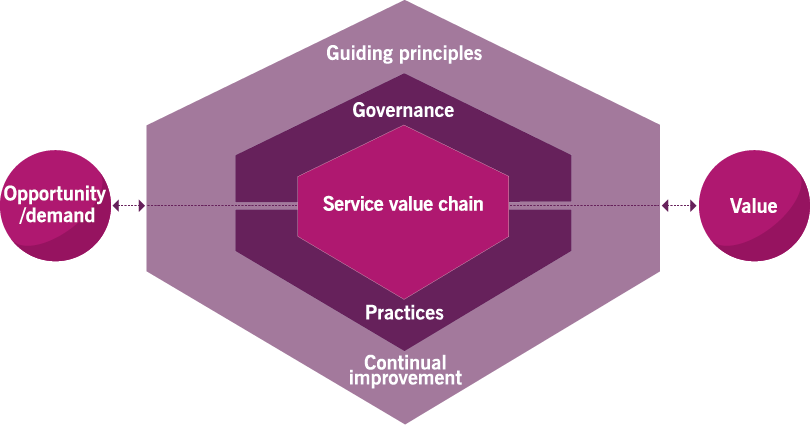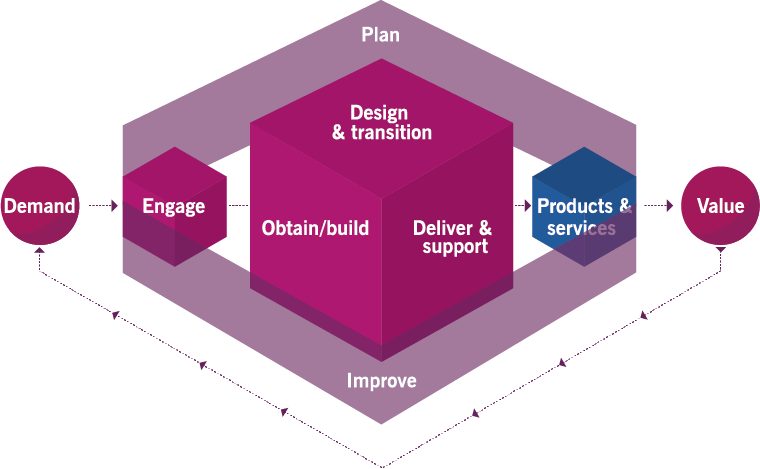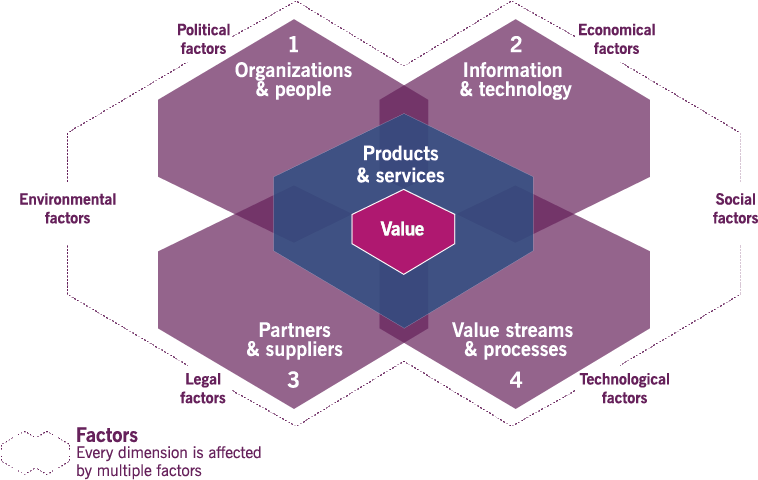News & Blog
What are the benefits of ITIL® in 2022?
Benefits for organisations of all sizes
As the pandemic accelerates the digitisation of businesses, and society as a whole, IT and IT services are becoming ever more critical. We’re moving closer to being a cashless society and people are increasingly homeworking – IT services are now the linchpin for businesses of all sizes. The ITIL® framework provides the guidance needed for overall control and ultimate success.
A key area for any business is customer service. ITIL provides guidance on setting up a Service Desk to support customers. This is not just for dealing with issues, it is also for questions and general help. The ITIL framework includes practices giving guidance on several areas but these do not need to be implemented by different staff. In fact, one person could carry out a number of practices, which would be the situation in a small business. The benefit of following ITIL guidance is to ensure each practice is being applied in the most efficient way possible.
It is very viable for small businesses to consider only the IT area, or areas, they are having issues with and focus on that alone: small businesses do not need to implement all parts of ITIL. This approach will bring benefits.
Introduction to ITIL 4
ITIL, like all frameworks, needs to evolve as innovations in technology appear and people’s way of working changes. In fact, ITIL, possibly more than other frameworks, should be more focused on evolving as a major part of ITIL is Continual Improvement.
ITIL 4 was developed to allow more flexibility in the choices of methodologies for the development and management of services and not to limit the possible use of future methods.
Now in its fourth iteration, it still adheres to the idea that organisations can adopt the guidance provided and then adapt it to their own way of working.
Creating value for customers and providers
The term value is an interesting one. ITIL defines value as “The perceived benefits, usefulness and importance of something”. This might appear at first as a loose, wide-ranging definition but it is actually a very good definition as it focuses on differing perception. One person’s view of something being of value may not be another person’s view. In an IT context, an application might be valuable to one group in an organisation but have little or no value to another.
ITIL 4 encourages the concept of value being co-created so value is created for both the provider and consumer of a service. The consumer needs to get value or there is no point in them using the service, and the provider has to get value or there is no point in supplying the service. Value is not just measured in monetary terms; it could be created from more efficient working from a consumer view or by creating new opportunities from a provider view.

Building relationships
One of the main factors in the co-creation of value is building relationships that are beneficial to all parties involved. ITIL refers to these as Service Relationships and provides guidance on how to establish and manage these relationships.
An example of a service relationship would be an organisation having a contract with a Cloud service provider. This agreement has to be put together so that both parties get value, the organisation gets the required level of service and the provider receives the appropriate recompense.
Valuable outcomes
It is important to distinguish between Outputs, Outcomes, and Value. ITIL defines an output as “A tangible or intangible deliverable of an activity” and an outcome as “A result for a stakeholder enabled by one or more outputs”. Here is an illustration of output, outcome, and value:
Output: A new parts warehouse system
Outcome: Allows complete integration with robotic pickers
Value: The lead times for shipping of parts is reduced by 25%
Value is based on not only the outcomes but also the customer’s preferences and perceptions for the service.
Whether something is of value or not is mainly decided by the consumer. A scenario could be:
An organisation is looking to replace its payroll system to allow better integration with its HR system. There are a number of providers in the marketplace who can provide a solution to meet the organisation’s requirements so the outcome can be satisfied. This is where preferences and perceptions could come into play and the human factor kicks in. Maybe a senior manager in the organisation has had a bad experience with one of the possible providers in the past and that manager has a perception that the provider in question does not provide value. This could influence the final provider decision.
Being more Agile
One of the key concepts of ITIL 4 is the Service Value System (SVS). The SVS describes how the elements of an organisation work together to create value. The components of the SVS are:
- Guiding Principles: Recommendations to guide organisations
- Practices: Sets of organisational resources for doing work
- Governance: How an organisation is managed and controlled
- Continual Improvement: An ongoing activity to ensure needs are being met
- Service Value Chain (SVC): Interconnecting activities to deliver a service

Inputs to the SVS are opportunities, possibilities to add value, or demand, organisations identify they have a need for a service. The output should be the co-creation of value.
The SVC viewed as being an operating model for creating, delivering and ongoing improvements to services. The SVC is not a linear chain but a set of six activities that can be combined in various ways to build service value streams. The activities are:
Plan: Ensures an understanding of the vision and direction
Improve: Ensures continual improvement in all areas
Engage: Ensures continual engagement with all stakeholders
Design and Transition: Ensure all services meet expectations
Obtain/build: Ensures all components that make up a service are available when needed
Deliver and Support: Ensures services are delivered and supported in the operational environment

An organisation will have multiple value streams, each one to deal with a particular need. Some Value Stream examples are:
- Dealing with an incident
- Installing a security update
- Implementing a new service
- Managing a change request
Looking at the “Dealing with an incident” value stream:
The demand to trigger the stream would be something is not working.
Engage would be communication between the user and a service desk.
Deliver and support would be the resolving of the incident.
Engage would be service desk informing the user the incident was resolved.
The value is the user can get back to work.
Not all activities have to be used and some can be used multiple times.
The SVC allows these value streams to be built without limiting the development to a specific methodology. Thus allowing organisations the flexibility to use the methodology that is most appropriate in any particular situation. One part of an organisation could be using traditional waterfall methods of project management (water falls relentlessly downhill and so this kind of project management follows a predetermined path with no loops back or adaptation) while another part of the organisation might be using an Agile development method such as Scrum – it should be noted that PRINCE2 Agile allows for both approaches to be used as appropriate.
Adopting the SVC approach means that the model would still apply should any new methods become popular in the future.
At the moment Agile ways of working are very popular in the IT space, ITIL 4 acknowledges this in one of its guiding principles which is “Progress iteratively with feedback”. This principle suggests that work to be done is broken down into small, manageable sections, Agile methods would refer to these as increments, with feedback before, during and after each iteration.
Looking at the big picture
Nothing works in isolation; one of the ITIL 4’s guiding principles is “Think and work holistically”. An understanding of how all areas of an organisation interrelate is key to ensuring that value is created from using IT services. This can be linked to the concept of “systems thinking” where services are considered in the context of a much larger organisational system.
If the overall system in not considered, there is a danger that changes to one element will have an unexpected and potentially damaging impact on another element causing the value of the change to be lost.
As mentioned earlier, the Service Value System is a key component of ITIL 4. The other key component is the Four Dimensions Model. This is a major element of ITIL’s holistic approach as it provides guidance in the four areas that must be constantly considered in service management.

The four dimensions are:
- Organisations and people
- Information and technology
- Partners and suppliers
- Value streams and processes
Organisations and People
The ‘Organisations and People’ dimension gives guidance on the roles and responsibilities, organisational structures, culture, competencies, etc. are needed to create and deliver services of value to the organisation.
Information and Technology
The ‘Information and Technology’ dimension deals with the information required to manage services. This includes how to protect the information, any applicable regulatory requirements such as GDPR, etc. This dimension also includes any technology required to deliver the services, and to ensure that any new developments in technology are considered as part of continual improvement. The nature of an organisation’s business may impose limitations on the technology that can be used and also how the information can be managed. Global organisations need to be aware of differing country requirements for storage and movement of information. This is particularly relevant for organisations considering the use of Cloud Computing as it might be difficult to ascertain where the information is actually stored.
Partners and Suppliers
Every organisation depends, to a greater or lesser degree, on services provided by another organisation. The ‘Partners and Suppliers’ dimension gives guidance on this area. In today’s world no organisation is completely self-contained with no dependency on any other organisation.
There are many considerations when looking at potential partners and suppliers such as:
- Corporate Culture – e.g., use of a preferred supplier
- Outsourcing – might be cheaper but loses some control
- Expertise – might not have skills in-house
Value Streams and Processes
The last dimension is ‘Value Streams and Processes’. As stated earlier, value streams are interconnecting activities that deliver a service. In reality, these activities can be made up of workflows, controls and/or processes.
All four dimensions are affected by external factors. A common way to analyse these factors is using an analysis model such as PESTLE. This is an acronym for Political, Economic, Social, Technological, Legal and Environmental.
The Practices component of the Services Value System in ITIL provides specific and detailed guidance on how these four dimensions of service management can be addressed.
Being Efficient
The ITIL 4 guidance suggests that there are two areas to consider when looking at introducing a new service or making a change to a system.
Firstly, make sure there is a clear understanding of the current situation. This is dealt with by the ITIL principle of “Start where you are”. The guidance suggests that it is highly likely that some of what already exists will have value in the future. When looking to bring in a new service, many organisations adopt the approach of just getting rid of the old service without analysing it in detail. This can lead to a great deal of valuable detail of how the old service worked and was used being lost. This also ties in with the idea of thinking holistically as dependencies on other services may not be obvious.
Secondly, the ITIL “Keep it simple and practical” principle suggests that a good way of working is not to over-complicate things so try to use the minimum activities to achieve an objective. It is more efficient to start with an uncomplicated approach and then add controls and measurements when it becomes really necessary. Many services have been designed, built, and implemented, that have tried to deal with every possible eventuality or requirement. Frequently, portions of what has been developed are then rarely used and fail to justify the overall investment.

Considering governance from the start
Another critical component of the SVS is Governance. As stated earlier, ITIL 4’s view of governance is, “How an organisation is managed and controlled”.
Every organisation will have different governance requirements depending on the industry sector in which they operate. These requirements will apply to the entire organisation, not just ITIL service management, so they will need to be considered by everyone involved in delivering IT Services.
So, Why ITIL?
In an age when all businesses of all sizes have to engage with technology, ITIL guidance supports both organisations and individuals to achieve the most value from IT and digital services.
ITIL is a global standard for IT best practice. Whilst it is relied upon by 90% of the FTSE 500 to run their IT operations, it’s invaluable for small businesses too. At its core, ITIL is about powering effective collaboration to deliver IT value right across a business, and to support customers in the most efficient way.
We are now living in a new technological era. ITIL 4 provides the guidance needed for organisations of all sizes to navigate new challenges – aligning human, digital and physical resources to provide high quality and value-driven IT for people and organisations.
For more information on our ITIL 4 Foundation course or to book onto our next available date.
Written by our PRINCE2 Agile and ITIL trainer, Bob Denham
ITIL guidance supports both organisations and individuals to achieve the most value from IT and digital services
Discover our other posts by category:
- Apprenticeships (3 posts)
- Armed Forces (7 posts)
- Company News (20 posts)
- Construction (7 posts)
- Courses (10 posts)
- Covid-19 (4 posts)
- Cyber and IT (4 posts)
- eLearning (6 posts)
- Engineering (2 posts)
- Events (4 posts)
- Exams (2 posts)
- Gamification (4 posts)
- Gas (1 post)
- Health and Safety (5 posts)
- ITIL (10 posts)
- Project
Management (21 posts) - Scaffolding (1 post)
- Technology (12 posts)
- Training Strategy (8 posts)